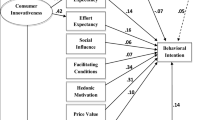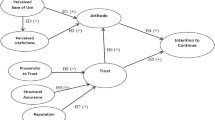Abstract
The scope of this work covers the study of models developed for assessing critical aspects of consumer use and acceptance of technology-based products and services. We used the Technology Acceptance Model (TAM), and the Index of Readiness for the use of Technology (TRI) as theoretical references. We carried out field research on Internet banking users in order to: (1) evaluate the differences between the groups in terms of predisposition towards technology using the TRI model; and (2) test whether the influencing factors of this model could be antecedents to the main construct of the technology acceptance model (TAM). The analyses showed that for proposal (1), three of the four dimensions, - optimism, insecurity and discomfort, - presented significant differences between the groups; and for proposal (2), the factor ´optimism‘, a positive view of technology, was observed to be a significant antecedent of the intention to use on-line services.
Access this chapter
Tax calculation will be finalised at checkout
Purchases are for personal use only
Preview
Unable to display preview. Download preview PDF.
Similar content being viewed by others
References
Davis, F.D.: Perceived usefulness, perceived ease of use, and user acceptance of information technology. MIS Quarterly 13(3), 319–341 (1989)
Parasuraman, A.: Technology readiness index (TRI): a multiple-item scale to measure readiness to embrace new technologies. Journal of Service Research 2(4), 307–320 (2000)
Parasuraman, A., Colby, C.: Techno-ready marketing: how and why your customers adopt technology. The Free Press, New York (2001)
Davis, F.D., Bagozzi, R.P., Warshaw, P.R.: User acceptance of computer technology: a comparison of two theoretical models. Management Science 35(8), 982–1004 (1989)
Taylor, S., Todd, P.: Understanding information technology usage: a testing of competing models. Information Systems Research 6(2), 144–176 (1995)
Dasgupta, S., Granger, M., Mcgarry, N.: User acceptance of e-collaboration technology: an extension of the technology acceptance model. Group Decision and Negotiation, 87–100 (2002)
Venkatesh, V., Morris, M.G., Davis, G.B., Davis, F.D.: User acceptance of information technology: toward a unified view. MIS Quarterly 27(3), 425–478 (2003)
Keat, K.T., Mohan, A.: Integration of TAM based electronic commerce models for trust. Journal of American Academy of Business 5(1-2), 404–410 (2004)
Taylor, S.A., Goodwin, S., Celuch, K.: An exploratory investigation into the question of direct selling via the internet in industrial equipment markets. Journal of Business to Business Marketing 12(2), 39–54 (2005)
de Souza, R.V., Luce, F.B.: Assessment of applicability of TRI index for the adoption of technology-based products and services in Brazil. In: Anais do Encontro Nacional da Associação Nacional de Pós-Graduação e Pesquisa em Administração, Atibaia, SP, Brasil, vol. 27 (2003)
de Souza, R.V., Luce, F.B.: Assessment of applicability of TRI index for the adoption of technology-based products and services. Revista de Administração Contemporânea 9(3), 121–141 (2005)
Meuter, M.L., Ostrom, A.L., Roundtree, R.I., Bitner, M.J.: Self-service technologies: understanding customer satisfaction with technology-based service encounters. Journal of Marketing 64(3), 50–64 (2000)
Dabholkar, P.A.: Incorporating choice into an attitudinal framework: analyzing models of mental comparison processes. Journal of Consumer Research 21(1), 100–118 (1994)
Clemons, E.K., Hitt, L., Gu, B., Thatcher, M.E., Weber, B.W.: Impacts of e-commerce and enhanced information endowments on financial services: a quantitative analysis of transparency, differential pricing, and disintermediation. Journal of Financial Services Research 22(1-2), 73–90 (2002)
Frei, F., Harker, P.: Value creation and process management: evidence from retail banking. Working Paper (99-16). Wharton Financial Institutions Center, Philadelphia (1999)
Fishbein, M., Ajzen, I.: Belief, attitude, intention, and behavior: an introduction to theory and research. Addison-Wesley, Reading (1975)
Karahanna, E., Straub, D.W., Chervany, N.L.: Information technology adoption across time: a cross-sectional comparison of pre-adoption and post-adoption beliefs. MIS Quaterly 23(2), 183–218 (1999)
Gefen, D.: TAM or just plain habit: a look at experienced online shoppers. Journal of End User Computing 15(3), 1–13 (2003)
Aaker, D.A., Kumar, V., Day, G.S.: Marketing research. John Wiley & Sons, Inc., New York (1995)
Eagly, A.H.C.: The psychology of attitudes. Harcourt Brace Jovanovich, Forth Worth (1993)
Mathieson, K.: Predicting users intentions: comparing technology acceptance model with the theory of planned behavior. Information Systems Research 2(3), 173–191 (1991)
Robey, D.: Theories that explain contradiction: accounting for the contradictory organizational consequences of information technology. In: Proceedings of the International Conference on Information Systems, Amsterdam, Netherlands (1995)
Gentry, L., Calantone, R.: A comparison of three models to explain shop-bot use on the web. Psycology & Marketing 30(3), 184–202 (2002)
Hair Jr., J.F., Babin, B., Money, A.H., Samouel, P.: Fundamentos de métodos de pesquisa em administração (Foundations of research methods in management). Bookman, Porto Alegre (2005)
Bentler, P.M.: EQS – structural equations program manual. Multivariate Software, Inc., Encino (1995)
Jöreskog, K.G., Sörbom, D.: LISREL 8: structural equation modeling with SIMPLIS command language. Scientific Software, Mooresville (1993)
Mick, D.G., Fournier, S.: Paradoxes of technology: consumer cognizance, emotions, and coping strategies. Journal of Consumer Research 25(2), 123–143 (1998)
Churchill Jr., G.A.: Marketing research: methodological foundation, 7th edn. The Dryden Press, Orlando Fla (1999)
Adams, D., Nelson, R., Todd, P.: Perceived usefulness, ease of use, and usage of information Technology: a replication. MIS Quarterly 16(2), 227–248 (1992)
Agarwal, R., Prasad, J.: The role of innovation characteristics and perceived voluntariness in the acceptance of information technologies. Decision Sciences 28(3), 557–582 (1997)
Chen, P., Hitt, L.: Measuring switching costs and the determinants of customers retention in internet-enabled businesses: a study of the online brokerage industry. Information Systems Research 13(3), 255–276 (2002)
Curran, J., Meuter, M.L., Suprenant, C.F.: Intentions to use self-service technologies: a confluence of multiple attitudes. Journal of Service Research 5(3), 209–225 (2003)
Hair Jr., J.F., Anderson, R.E., Tathan, R.L., Black, W.C.: Multivaried data analysis, 5ath edn. Bookman, Porto Alegre (2005)
Hauser, J.R., Shugan, S.M.: Intensity measures of consumer preference. Operation Research 28(2), 278–320 (1980)
Hitt, L.M., Frei, X.F., Harker, P.: How financial firms decide on technology. In: Robert, E. (ed.) Brookings-Wharton Papers on Financial Services, pp. 93–146. Financial Institutions Center, Philadelphia (1999)
Hitt, L.M., Frei, X.F.: Do better customers utilize electronic distribution channels? The case of PC Banking. Management Science 48(6), 732–748 (2002)
King, W.R., He, J.: A meta-analysis of the technology acceptance model. Information & Management 43(6), 740–755 (2006)
Larcker, D.F., Lessig, U.P.: Perceived usefulness of information: a psychometric examination. Decision Sciences 11(1), 121–134 (1980)
Ma, Q., Liu, L.: The technology acceptance model: a meta-analysis of empirical findings. Journal of Organizational and End User Computing 16(1), 59–72 (2004)
Moore, G.C., Benbasat, I.: Development of an instrument to measure the perceptions of adopting an information technology innovation. Information Systems Research 2(3), 192–222 (1991)
Mowen, J.C., Minor, M.S.: Comportamento do consumidor. Prentice Hall, São Paulo
Rogers, E.M.: Diffusion of innovation. The Free Press, New York (2003)
Swanson, E.B.: Information Channel Disposition and Use. Decisions Sciences 18(1), 131–145 (1987)
Swinyard, W., Ghee, L.: Adoption patterns of new banking technology in Southeast Asia. International Journal of Bank Marketing 5(4), 35–48 (1987)
Venkatesh, V., Davis, F.D.: Theoretical extension of the technology acceptance model: four longitudinal field studies. Management Science 46(2), 186–204 (2000)
Author information
Authors and Affiliations
Editor information
Editors and Affiliations
Rights and permissions
Copyright information
© 2011 Springer-Verlag Berlin Heidelberg
About this paper
Cite this paper
Pires, P.J., da Costa Filho, B.A., da Cunha, J.C. (2011). Technology Readiness Index (TRI) Factors as Differentiating Elements between Users and Non Users of Internet Banking, and as Antecedents of the Technology Acceptance Model (TAM). In: Cruz-Cunha, M.M., Varajão, J., Powell, P., Martinho, R. (eds) ENTERprise Information Systems. CENTERIS 2011. Communications in Computer and Information Science, vol 220. Springer, Berlin, Heidelberg. https://doi.org/10.1007/978-3-642-24355-4_23
Download citation
DOI: https://doi.org/10.1007/978-3-642-24355-4_23
Publisher Name: Springer, Berlin, Heidelberg
Print ISBN: 978-3-642-24354-7
Online ISBN: 978-3-642-24355-4
eBook Packages: Computer ScienceComputer Science (R0)




